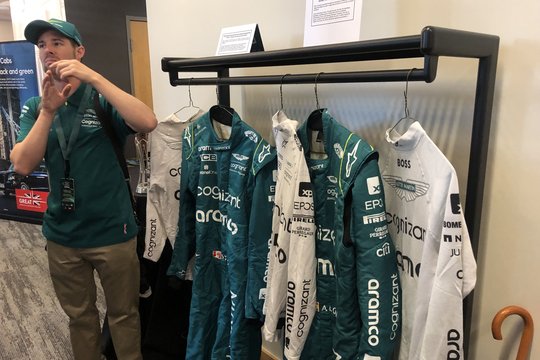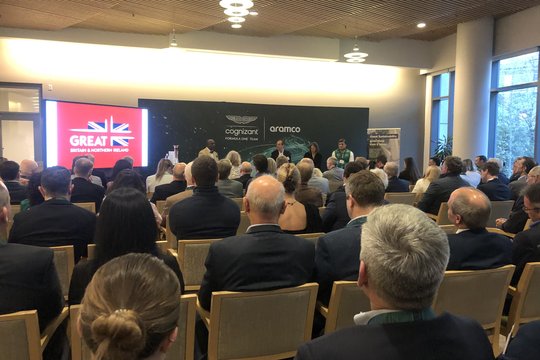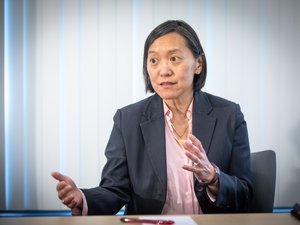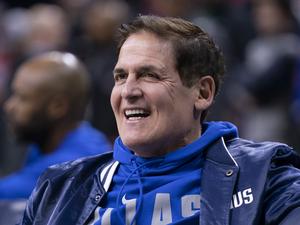Click through the photos in the gallery above.
Last year, Aston Martin finished seventh in the Formula One Constructor Standings, far behind the big names of Red Bull and Ferrari, and even behind its closer competitors Alpine and McLaren. This year, the underdog is sitting in second position (again behind Red Bull).
Late last week, members of the Aston Martin Aramco Cognizant Formula One Team were at MIT's Sloan School of Management for an event hosted by the British Consulate in Boston to discuss innovation and sustainability. Leaders from the Aston Martin Formula One team and MIT discussed what’s behind Aston Martin’s meteoric rise in the team standings this year, innovations on the horizon and more.
Aston Martin moves up the leaderboard
The Aston Martin Formula One team spends its year trying to produce two cars that are capable of scoring the team points, or in the best-case scenario, landing on the podium at the end of the races each week. To get there, the team employs 800 people, including 150 aerodynamicists.
The panel speakers last week included Jeff Slack, managing director of Aston Martin Formula One; Shergul Arshad, head of North America for Aston Martin Formula One; and Fiona Murray, professor of entrepreneurship and associate dean of innovation and inclusion at MIT. Slack said the team spends about $300 million a year. Formula One teams have a $135 million cost cap in 2023, with some flexibility for the extra races this year, but the cap does not include things like driver salaries or travel costs.
Slack said everyone has been asking what the team did over the winter to advance its car so much.
“It wasn’t what we did over the winter. It’s what we’ve been doing for the last three, four years,” he said.
Last year, Slack admitted, they got the aerodynamics of the car wrong. So this year they “ripped up the playbook.”
“A few races later we put out a new car and that helped us get a little bit faster last year, and built on that for this year,” Slack said.
One of the strategies Slack credited with the team’s rise was listening to a variety of inputs on how to improve its aerodynamics. He said Aston Martin hired someone from Red Bull and someone from Mercedes, each of whom had their own aerodynamics philosophy.
“They’ve made a huge impact because they’re thinking about it from all kinds of different ways,” Slack said. “And that’s why this year we’ve made a leap that’s probably never happened in Formula One without a major regulatory change.”
Innovations on the horizon
Slack said the company is laying the groundwork for continued innovation for years to come. First up is the opening of a new factory at the Silverstone racing track in England next month. Aston Martin will have three new buildings totaling 400,000 square feet there.
Arshad said that Aston Martin is putting sustainability into practice in the new factory by installing solar panels, LED-reducing light bulbs and trees. On the commercial side, Arshad said Aston Martin will soon launch an electric vehicle.
Murray said sustainability goals will also further push teams to innovate on their cars. And she believes such goals will bring new faces to Formula One who are competitive and mission-driven, with sustainability in mind.
“I think that will also require us to bring in people who’ve not normally been part of these technical conversations, that we do need people who think about batteries, we do need people who think about sustainable fuels,” Murray said.
F1’s innovation hub
Just as San Francisco and Boston are tech hotspots, England is a Formula One hub of innovation. The country is home to seven out of the 10 teams on the grid. Murray said such a concentration creates a competitive environment that drives innovation.
“You have intense competition every time that people are on the racetrack. And that matters. And that gives everybody that sort of energy, literally, to keep on going,” Murray said. “But you also have all sorts of cooperation, collaboration and you have a community of enthusiasts that it is kind of grounded in.”
Slack added that the close proximity of so many teams has created an “ecosystem of expertise,” especially around building engines and meeting the constantly changing rules of Formula One. For example, by 2026 all F1 cars will be running on 100% sustainable fuel. Slack said the cars are operating on hybrid fuel right now.
Murray did warn that there are potential downsides to having such an interconnected ecosystem, namely the danger of “groupthink” and not bringing in new voices.
Slack said he felt Aston Martin had done a good job of bringing in different opinions, pointing to the example of bringing in aerodynamics experts from different teams. Ultimately, he said, the proof is in the standings.
“The good thing about sport is we are judged every weekend. It’s on the track with precise measurements and you know exactly where you stand. So we have to innovate well,” Slack said. “We seem to have gotten that right so far this year.”
Sign up for The Beat, BostInno’s free daily innovation newsletter. See past examples here.














